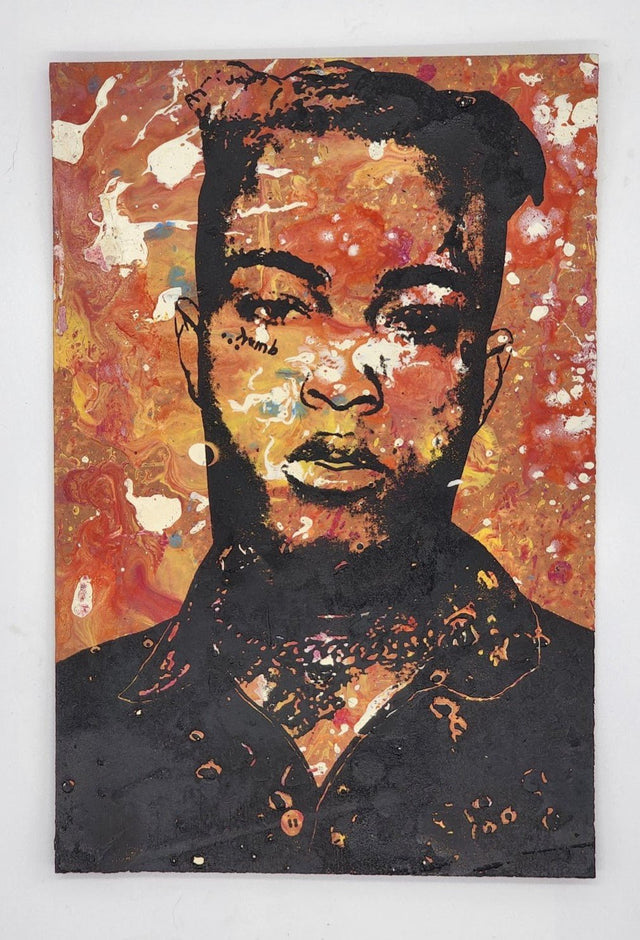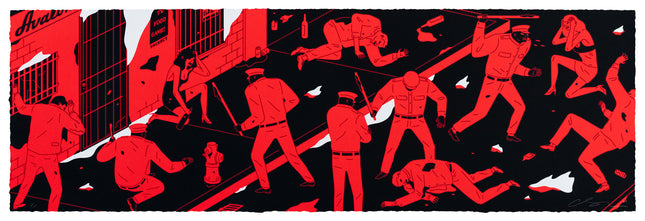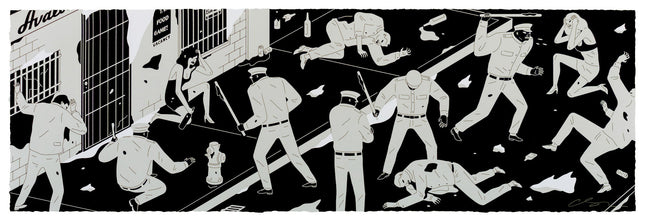
Man Male

Cleon Peterson Cruelty Is the Message Red Silkscreen Print by Cleon Peterson
Cruelty Is the Message Red Silkscreen Print by Cleon Peterson on Hand Deckled 290gsm Coventry Rag Fine Art Paper Limited Edition Artwork. 2024 Signed & Numbered Cleon Peterson Limited Edition of 125 Artwork Size 44x14 Silkscreen Print. Deciphering the Red Palette: "Cruelty Is the Message" by Cleon Peterson Cleon Peterson's "Cruelty Is the Message Red" silkscreen print unfolds a visually compelling narrative steeped in street pop art's stark contrasts and graffiti artwork's rebellious ethos. With its release in 2024, this limited edition piece joins the pantheon of Peterson's work, known for its unflinching portrayal of violence, power, and chaos. The artwork, spanning a commanding size of 44x14 inches, is a testament to Peterson's unyielding exploration of societal undercurrents, meticulously hand-deckled on 290gsm Coventry Rag fine art paper. Peterson's Vivid Interpretation of Societal Dynamics The limited series, numbering merely 125, is an exclusive collection wherein each print is signed and numbered, underscoring the value and collectibility of Peterson's work. With its bold red and black hues, this edition draws the viewer into a tumultuous world where conflict and turbulence are the prevailing themes. The color red, often associated with danger, passion, and aggression, pulsates throughout the composition, enhancing the impact of the depicted struggles and confrontations. Peterson's choice of fine Coventry Rag paper elevates the silkscreen print, a medium traditionally linked with high art and mass production, further blurring the lines between gallery art and street expression. The hand-deckled edges add an individual touch to each print, hinting at the personalized nature of street art despite the work's existence within a limited series. The Cultural Resonance of Peterson's Artwork "Cruelty Is the Message Red" holds a mirror to the society it critiques, showcasing Peterson's ability to navigate the interplay between art as a vehicle for aesthetic pleasure and art as a means for profound commentary. The scale and execution of this piece place it firmly within the discourse of street pop art, which often challenges viewers to confront uncomfortable realities and engage with the underlying messages conveyed through stark, uncompromising imagery. Through his distinctive visual language, Peterson not only chronicles the darker aspects of human behavior but also invokes reflection on the cyclical nature of dominance and submission, control, and uprising. His work resonates within the zeitgeist of contemporary social issues, serving as a stark reminder of the ongoing struggle against oppression and injustice. Cleon Peterson's "Cruelty Is the Message Red" is impactful in street pop art and graffiti artwork. It is a bold assertion of the artist's vision, offering a narrative that is as aggressive as it is intricate. This silkscreen print solidifies Peterson's reputation as a seminal figure in modern art. It continues to provoke, challenge, and inspire audiences, reaffirming the power of visual art to encapsulate and question the dynamics of power within society.
$2,000.00

Cleon Peterson Cruelty Is the Message Bone Silkscreen Print by Cleon Peterson
Cruelty Is the Message Bone Silkscreen Print by Cleon Peterson on Hand Deckled 290gsm Coventry Rag Fine Art Paper Limited Edition Artwork. 2024 Signed & Numbered Cleon Peterson Limited Edition of 125 Artwork Size 44x14 Silkscreen Print. Cleon Peterson's Gritty Reflection in "Cruelty Is the Message Bone" "Cruelty Is the Message Bone," a powerful silkscreen print by Cleon Peterson, presents a stark tableau as provocative as it is aesthetically arresting. Released in 2024, it forms part of a limited edition of 125 pieces, each bearing the artist's signature and individual number, confirming its exclusivity and importance in contemporary art. This artwork, measuring 44x14 inches, is printed on hand-deckled 290gsm Coventry Rag fine art paper, underscoring Peterson's commitment to quality and durability in his works. Dissecting the Visual Language of Conflict Peterson's monochromatic palette, dominated by bone-like whites and unforgiving blacks, delves into the dichotomy of chaos and order, power and vulnerability. Each figure is interlocked in scenes of violence and domination, creating a narrative that reflects on the inherent brutality within societal structures. The artwork resonates with the rawness of street pop art and graffiti artwork, carrying an unfiltered expression of human behavior stripped to its most primal forms. The imagery in "Cruelty Is the Message Bone" is characteristic of Peterson's oeuvre, wherein themes of conflict, authority, and aggression are recurrent. He employs a visual lexicon that is both universal and timeless, drawing parallels between historical cycles of power and contemporary instances of systemic violence. Peterson's work is a commentary not only on the societal but also on the personal realms of struggle and survival. The Impact of Peterson's Silkscreen on Street Art Discourse Peterson's work stands at the intersection of fine art and street art, drawing the meticulousness of printmaking into the often fleeting world of graffiti art. "Cruelty Is the Message Bone" is a testament to the potential of street pop art to transcend its origins and find a place within the more traditional art settings, all while retaining its edge and ability to provoke thought. The limited edition print's presence in the art market is a reminder of the genre's evolving dynamics, showcasing the shifting boundaries between high art and street art. With his stark depictions, Cleon Peterson captures the essence of the times, challenging viewers to confront uncomfortable truths about the world and their role within it. Cleon Peterson's "Cruelty Is the Message Bone" is a striking embodiment of the spirit of street pop art and graffiti artwork. It is a visual feast that delves into the depths of societal unrest and personal upheaval, serving as a mirror to the chaos and order that define the human condition. With its distinctive style and provocative themes, Peterson's work continues to contribute to the conversation around art's role in reflecting and shaping the socio-political landscape.
$2,000.00



